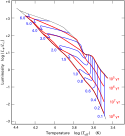Henyeyspåret

Stjärnor med stor massa har en utveckling som går i nästan horisontella spår tills de når huvudserien. För mindre massiva stjärnor går utvecklingsspåret nästan vertikalt som ett Hayashispår.
Längst till vänster i varje spår anges respektive stjärnmassa i solmassor räknat, vilket också visar dess position i huvudserien.
Henyeyspåret är ett nästan horisantalt utvecklingsspår i Hertzsprung-Russell-diagrammet, som bildas när protostjärnor närmar sig huvudserien, sedan det protostellära molnet nått en ungefärlig hydrostatisk jämvikt. Det gäller protostjärnor med en massa av mer än 0,5 solmassor (M☉).[1]
Begreppet har fått namn efter den ungersk-amerikanske astronomen Louis G. Henyey som tillsammans med sina kollegor på 1950-talet visade att stjärnor före huvudserien kan utvecklas med konstant luminositet, för att energitransporten sker med strålning i hela stjärnan.[1]
För stjärnor med liten massa transporteras istället värmen genom konvektion, där stjärnan följer ett Hayashispår.
Referenser
Media som används på denna webbplats
Pre-main-sequence (PMS) evolutionary tracks.
These tracks show the relationship between luminosity and temperature holding for pre-main-sequence stars of different masses.
- Each PMS track (blue lines) is labeled by the stellar mass in units of M☉ (the mass of the sun). The red curves intersecting the tracks are isochrones which give the age of an evolving star at the intersection and are labeled in years. As an example, stars 106 years old lie along the curve labeled 106.
- The PMS tracks start at the stars birth depicted by the isochrone (which is the upper black line near the 105 yr isochrone) and end when the star is entering the zero age main sequence (ZAMS) (which is the lower black line near the 108 yr isochrone).
- The nearly vertical parts of the tracks which exist for stars weighing up to three solar masses are called Hayashi tracks, whereas the horizontal parts connecting Hayashi tracks and the ZAMS are called Henyey tracks.

